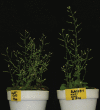Polyamines: ubiquitous polycations with unique roles in growth and stress responses
- PMID: 19828463
- PMCID: PMC2794062
- DOI: 10.1093/aob/mcp259
Polyamines: ubiquitous polycations with unique roles in growth and stress responses
Abstract
Background: Polyamines are small polycationic molecules found ubiquitously in all organisms and function in a wide variety of biological processes. In the past decade, molecular and genetic studies using mutants and transgenic plants with an altered activity of enzymes involved in polyamine biosynthesis have contributed much to a better understanding of the biological functions of polyamines in plants.
Possible roles: Spermidine is essential for survival of Arabidopsis embryos. One of the reasons may lie in the fact that spermidine serves as a substrate for the lysine hypusine post-translational modification of the eukaryotic translation initiation factor 5A, which is essential in all eukaryotic cells. Spermine is not essential but plays a role in stress responses, probably through the modulation of cation channel activities, and as a source of hydrogen peroxide during pathogen infection. Thermospermine, an isomer of spermine, is involved in stem elongation, possibly by acting on the regulation of upstream open reading frame-mediated translation.
Conclusions: The mechanisms of action of polyamines differ greatly from those of plant hormones. There remain numerous unanswered questions regarding polyamines in plants, such as transport systems and polyamine-responsive genes. Further studies on the action of polyamines will undoubtedly provide a new understanding of plant growth regulation and stress responses.
Figures



References
-
- Bagni N, Tassoni A. Biosynthesis, oxidation and conjugation of aliphatic polyamines in higher plants. Amino Acids. 2001;20:301–317. - PubMed
-
- Cona A, Rea G, Angelini R, Federico R, Tavladoraki P. Functions of amine oxidases in plant development and defense. Trends in Plant Science. 2006;11:80–88. - PubMed
-
- Dobrovinskaya OR, Muñiz J, Pottosin II. Inhibition of vacuolar ion channels by polyamines. Journal of Membrane Biology. 1999;167:127–140. - PubMed
Publication types
MeSH terms
Substances
LinkOut - more resources
Full Text Sources
Other Literature Sources
Miscellaneous

